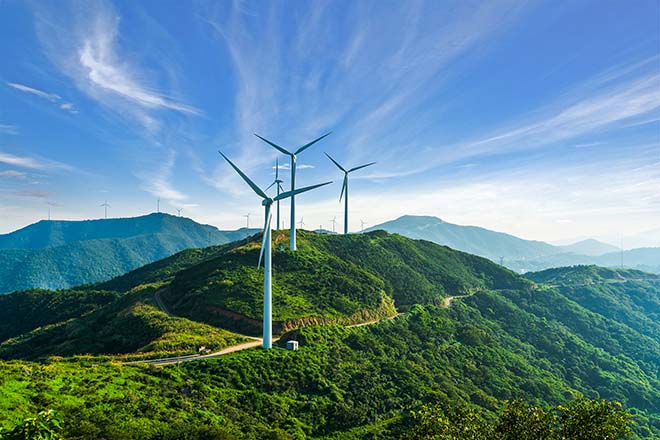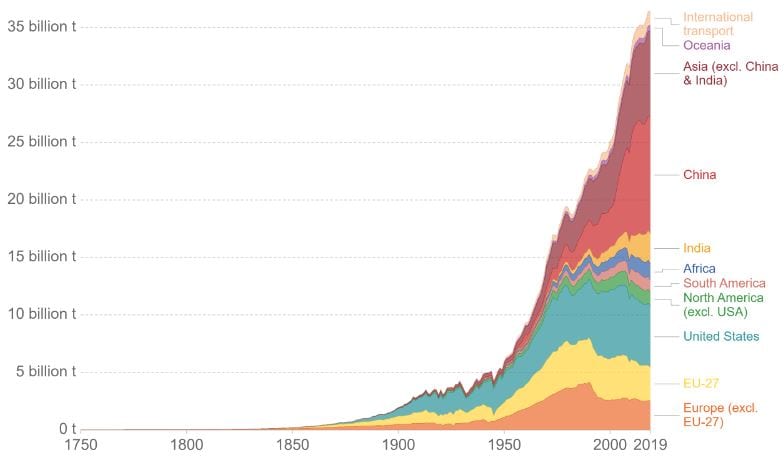China decarbonisation: the emergence of a mega-theme
At the 2020 United Nations General Assembly, Chinese President Xi Jinping caught the world's attention when he stated that his country would target peak carbon emissions in 2030 and seek to achieve carbon neutrality by 2060.

11 minute read
Key takeaways:
- The investment implications of China’s decarbonization program are massive and will play out over decades, creating winners and losers. Importantly, this mega-theme will reach far beyond China’s shores and impact multiple companies, sectors and asset classes.
- While the environmental implications are clear, decarbonization would also likely address social factors by creating jobs in value-added technologies and improving the health outcomes and standard of living for both Chinese citizens and those of other countries.
- China is already among the leaders in the supply chain for solar and wind technology. It is positioning itself to do the same with electric vehicles (EV) and batteries. With the state creating a conducive environment for innovative renewable tech companies, the country may achieve its goal of becoming a value-added industry leader in a way that has eluded it in other sectors.
Considering that China, home to the second-largest economy in the world, is the world’s largest carbon emitter and President Xi’s targets are more ambitious than those of other industrialized countries, this initiative has the potential to reframe the global debate on what’s possible when addressing climate change.
Reaching carbon neutrality will not be easy. It will require an overhaul of China’s energy mix and a fundamental shift in the composition of its economy. Yet, it is possible given China’s top-down decision making and its centralized political system.
Recent history has illustrated that when the country’s central government puts the full weight of its resources behind major initiatives such as those laid out in its Five-Year Plans, even the most aggressive objectives can be achieved.
The investment implications of China’s decarbonization program are massive. These will play out over decades and there will be winners and losers. Importantly, this mega-theme will reach far beyond China’s shores and impact multiple companies, sectors and asset classes.
It also stands to raise China’s stature in the realm of environmental, social and governance (ESG) investing. The environmental implications are clear. Decarbonization would also likely address social factors by creating jobs in value-added technologies and improving the health outcomes and standard of living for both Chinese citizens and those of other countries.
The cost of growth
In China’s rapid ascent to becoming the world’s second-largest economy, it also achieved the more dubious distinction as the largest carbon emitter. The reason for this is clear: developed nations largely offshored much of their manufacturing capacity to the Asian giant that was eager to climb the economic value chain.
Exhibit 1: annual global CO2 emissions (tonnes)

The conventional assumption is that China placed economic objectives over environmental stewardship as it sought to increase national wealth. To an extent, that may have been true in the past. China burns more coal than any other nation and was responsible for more than a quarter of world greenhouse gas emissions in 20191. For years, articles on climate change inevitably included photographs of Chinese residents wearing face masks to avoid particulates as heavy, gray fog hung over cities. That image is changing.
In 2013, Chen Jiping, a former Chinese Communist Party (CCP) official, remarked that pollution had displaced land disputes as the leading cause of social unrest. Soon after, the National People’s Congress reinforced environmental regulation with the Environmental Protection Law and, in 2015, President Xi announced specific commitments within the framework of the Paris Climate Agreement. Mr. Xi’s recent comments on decarbonization further codify the central government’s resolve in addressing the climate issue.
The magnitude of the task facing China is illustrated by the persistently high share of the country’s energy mix still attributable to fossil fuels despite a considerable push toward renewables. Over the past three decades overall energy demand has grown at a 6% annual pace. As the economy continues to expand, energy consumption will rise along with it. While some progress has been made – hydrocarbons’ share of overall energy demand has fallen from 96% in 1990 to 85% in 2019 – the objective of economic growth, at least in the near term, can only be achieved with a large contribution from fossil fuels.
It’s not just power generation driving hydrocarbon usage. The share of total electricity production attributable to coal has fallen five percentage points over the past three decades to 66% (over the same period, total renewables’ share has risen from 20% to 31%). However, over a quarter of coal’s usage emanates from industry, including its role as feedstock for steel production.
Time to act
Chinese authorities have chosen now to double down on their decarbonization commitment because the political and economic calculus is clear and compelling. From the perspective of the CCP, whose hallmark is continuity and stability, it is in China’s best interest to decarbonize as environmental, social, economic and geopolitical factors are all aligned. From an environmental and social perspective cleaner air equals a healthier, happier and likely more productive population.
From an economic perspective, a shift away from fossil fuels to a less carbon-intensive economy offers considerable rewards. Renewables can help remove the reliance on imported fuel – for example, 73% of crude oil consumption in China is met by imports2. The growth of a home-grown renewables industry also means employment opportunities. This matters because coal mining has historically been an important source of jobs. As the Chinese economy becomes less carbon intensive and those positions go away, they need to be replaced. New opportunities in forward-looking renewables stand to offset lost mining jobs – and in a cleaner, safer and more productive working environment.
Exhibit 2: renewables jobs overtake coal mining jobs in China
For years, China has sought to gain a foothold in value-added technologies where it could dominate globally. Its push toward renewables presents that opportunity. Already, China is among the leaders in the supply chain for solar and wind technology. It is positioning itself to do the same with electric vehicles (EV) and batteries. With the state creating a conducive environment for innovative renewable tech companies, the country may achieve its goal of becoming a value-added industry leader in a way that has eluded it in other sectors.
Decarbonization also marries well with China’s policy of “dual circulation.” Greater self-sufficiency in terms of less reliance on foreign suppliers by the upgrading of its manufacturing base and more emphasis on domestic demand and services (internal circulation) acts as a controllable counterweight to foreign trade (external circulation). Chinese companies are also positioning themselves for localization in overseas renewables markets with partnerships and production by Chinese companies occurring abroad.
China’s decarbonization push is likely to be aided by its shift toward a less energy-intensive and more service-based economy. The historical driver behind the push toward a vastly different economic composition – favoring consumption and services – has been to increase self-reliance and reduce its exposure to the whims of the global business cycle. Greater consumption and more service also align with the government’s climate objectives as economies with such a composition tend to have a smaller carbon footprint relative to its economic output.
Geopolitically, decarbonization has the potential to achieve two important objectives: It addresses the country’s strategic vulnerability of being a net energy importer and it can increase its sway by becoming a leader in an increasingly important industry. With respect to the former, China is already the global leader in solar and wind production capacity. Despite its already sizable renewables footprint, the country is still reliant on coal for electricity production. Despite ample coal deposits, China must import coal to meet its base load needs.
By expanding its renewable electricity generation capacity – including nuclear and hydroelectric for base loads – the country will further decrease its reliance on imports. With respect to technological leadership, as the demand for renewable energy capacity grows globally, innovative Chinese companies and the central government can leverage their commanding position in these fields to achieve a host of geopolitical ends.
Challenging, but possible
We have seen that there is political enthusiasm, indeed imperative, to decarbonize but the targets are challenging. The table below highlights peak emissions and carbon neutrality dates: China intends to achieve in 30 years what many developed countries are taking twice as long to do.
Exhibit 3: calendar of country peak emissions and carbon neutrality
China has made progress on shifting the mix and reducing carbon intensity, but the absolute amount of fossil fuel demand remains near peak levels while carbon intensity remains well above that of the developed market. If China is going to dramatically reduce fossil fuel demand it must formulate policies aimed directly at power generation, transport and industrial sectors. By improving the energy efficiencies of these key sectors, along with the steady ascendency of consumption and services as economic drivers, the composition of China’s economy will look decidedly different in 2060 than it did only a few decades prior. Together, these factors have the potential to reduce, by some estimates, fossil fuels from 85% of total energy production in 2019 to 25% by 2060, with most of that resulting from the virtual elimination of use of natural gas and coal.
The transition toward more renewables has been aided by a development long in the making: After years of promise, the cost curve of solar and wind generation has dropped considerably, even approaching parity with some traditional power sources. Not only does this make renewables more cost competitive, it also reduces the need for state subsidies. As the economics of wind and solar allow these sources to stand on their own, electricity generation companies are likely to be more comfortable installing capacity without the fear that a shift in state support will impede their cost dynamics.
Investment implications
While the phrase is liberally applied by investors, few global developments actually rise to the level of “mega-theme.” China decarbonization, however, meets this standard. A summary observation is that this theme is concentrated on China and within the energy complex. It’s not. We believe that this ambitious initiative has the potential to change the landscape for multiple asset classes, regions and economic sectors. As with any paradigm shift, there will be winners and losers in each of these categories.
With the launch of its decarbonization initiative, a global arms race to renewable supremacy has begun.
China, as the world’s largest energy consumer, has shifted the calculus on climate economics. It has also thrust itself into a potential leadership position in innovative renewable technology.
As the largest energy consumer, much of this value chain will be a closed loop within China. Yet it also could export these technologies to other countries seeking to meet their – now accelerated – climate targets. Regional losers are likely to be hydrocarbon exporting countries that have failed to diversify their economies. This stands to not only weigh on the financial prospects of the production companies and refineries, but also on their sovereign debt and currencies. Leaders in the Middle East and Russia have just been put on notice that their economic status quo may have a finite shelf life.
Exhibit 4: China share of total global photovoltaic solar industry
Developed market energy companies also face headwinds. Given solar’s and wind’s focus on electricity production, coal miners appear acutely vulnerable. Oil companies face a longer-term threat as the potential for EVs and batteries increases, but even within China, hydrocarbons stand to be the primary fuel for transportation over the near term. Globally, industrial companies will compete to dominate business verticals such as solar, wind and EVs. Other industries affected by this initiative are waste disposal, carbon capture and the mining of the metals needed to support advanced energy production. Among these are copper, nickel, cobalt and lithium. As evidenced by this list’s compositions, battery technology and fuel cells are positioned to be a growth industry.
Given the multi-decade nature of this mega-theme, equities within the renewable energy value chain can be categorized as long-duration growth opportunities. Accordingly, they may attract high valuations, but the secular nature and the magnitude of this opportunity, in our view, should justify elevated earnings multiples – as long as they don’t get overextended. The capital expenditure to bring these initiatives to fruition is massive. Companies are likely to access debt markets to fund growth and often this issuance may benefit from state backing. Conversely, strategically disadvantaged hydrocarbon producers will likely see their earnings prospects deteriorate and balance sheet quality diminish. The rate at which this occurs will depend upon the specific segment in which these companies operate and the degree to which management teams recognize the threat.
As decarbonization touches state actors, multinationals across a range of sectors and societies at large, understanding its long-term investment implications requires a holistic, interdisciplinary approach. We believe that a country-level – and regional-level – macro lens is appropriate especially given the degree government policy will help shape the renewable playing field. China has fired the opening salvo and we expect other countries to follow. A company-focused lens is necessary as management teams across industries will need to conduct a strategic overview of their carbon footprint, addressing how they produce and consume energy. As in other periods of transition, some companies will pick winning strategies; other less forward-thinking ones risk an existential crisis.
Lastly, decarbonization aligns well with the acceleration of ESG investment themes. China has the potential to turn a vulnerability – its management of the environment – into a strength. Similarly, the social implications are considerable. Wage gains for workers engaged in more productivity-enhancing value-added industries, improved health outcomes for urban dwellers and ultimately a lower risk of social and economic disruption caused by the worst effects of climate change such as desertification, food insecurity and mass migration are all societal benefits from a large-scale shift toward renewable energy sources. Publicly listed corporations will be both drivers and driven by climate economics and this energy transition. Within the context of governance, management teams and boards will need a deep understanding of how the energy marketplace is changing so that they can develop strategies that enable them to act in the long-term interest of shareholders.
Footnotes
1Source: Bernstein, December 2020.
2Source: National Bureau of Statistics of China, June 30, 2020.
These are the views of the author at the time of publication and may differ from the views of other individuals/teams at Janus Henderson Investors. References made to individual securities do not constitute a recommendation to buy, sell or hold any security, investment strategy or market sector, and should not be assumed to be profitable. Janus Henderson Investors, its affiliated advisor, or its employees, may have a position in the securities mentioned.
Past performance does not predict future returns. The value of an investment and the income from it can fall as well as rise and you may not get back the amount originally invested.
The information in this article does not qualify as an investment recommendation.
Marketing Communication.
Important information
Please read the following important information regarding funds related to this article.
- Shares/Units can lose value rapidly, and typically involve higher risks than bonds or money market instruments. The value of your investment may fall as a result.
- Shares of small and mid-size companies can be more volatile than shares of larger companies, and at times it may be difficult to value or to sell shares at desired times and prices, increasing the risk of losses.
- Emerging markets expose the Fund to higher volatility and greater risk of loss than developed markets; they are susceptible to adverse political and economic events, and may be less well regulated with less robust custody and settlement procedures.
- This Fund may have a particularly concentrated portfolio relative to its investment universe or other funds in its sector. An adverse event impacting even a small number of holdings could create significant volatility or losses for the Fund.
- The Fund may use derivatives to help achieve its investment objective. This can result in leverage (higher levels of debt), which can magnify an investment outcome. Gains or losses to the Fund may therefore be greater than the cost of the derivative. Derivatives also introduce other risks, in particular, that a derivative counterparty may not meet its contractual obligations.
- If the Fund holds assets in currencies other than the base currency of the Fund, or you invest in a share/unit class of a different currency to the Fund (unless hedged, i.e. mitigated by taking an offsetting position in a related security), the value of your investment may be impacted by changes in exchange rates.
- Securities within the Fund could become hard to value or to sell at a desired time and price, especially in extreme market conditions when asset prices may be falling, increasing the risk of investment losses.
- The Fund may incur a higher level of transaction costs as a result of investing in less actively traded or less developed markets compared to a fund that invests in more active/developed markets.
- The Fund could lose money if a counterparty with which the Fund trades becomes unwilling or unable to meet its obligations, or as a result of failure or delay in operational processes or the failure of a third party provider.

